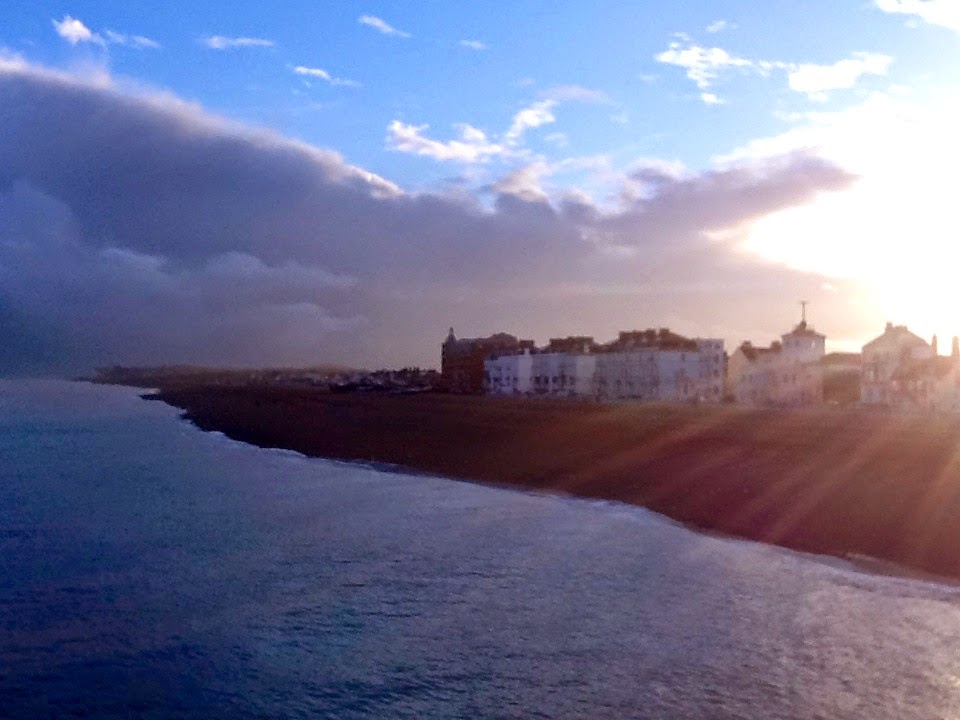Big Skies and Changeable
Weather
I’ve
spent a lot of time over the last week visiting various parts of the Kent coastline
and going for walks. These walks haven’t been anything arduous. I think that
it’s the ‘going out’ that is important.
John
Muir was a Scottish naturalist, who moved over to America and created the first
national parks, he said,
‘I went out for a walk, (and finally concluded to
stay out till sundown), for going out I found was really going in’. John Muir
Going
out, especially in the wintertime, when it’s snug and cosy indoors may not be
the priority for most of us. Unless you have a dog to walk, or don’t have
access to a car, it tends to be avoided. I am lucky enough to be able to drive,
so I can choose quite easily where I will walk and recently it has been a case
of picking friends up and driving to a favourite or new spot.
A flask of coffee
and biscuits or cake persuades most of them to join me on short, often wild,
windy and wet walks along the coast.
 |
| Snow coming? |
Of
course I can walk from where I live and I do. Walking a well known route
regularly has different benefits. The smaller details are recognised, such as
the movement of something small along the path, for example: a glove that had
been dropped onto the floor yesterday is now put up on a wall. This reminds me
that others walk here too. Another day the glove may have gone, has it been
reunited with its owner or is it in the bin?
 |
| My shadow finishes up on the beach! |
Small
manmade interventions happen every day and of course seasons change too. Nature
reminds us of the time passing, if we care to take note we can watch a whole
(plant)life cycle. I see the flowers of the Alexanders that thrive along the
coast here bloom, fade and then their seeds appear. Dark black seeds denote
where the plant thrived as its foliage shrinks back in the autumn. Now, most of
the seeds have disappeared but a few remain and I snack on them and enjoy their
Aniseed taste as I walk and I note that their foliage is regrowing now, (also
edible!).
 |
| Detail of chalk cliffs at Westgate. |
The
artist J.M.W. Turner loved the big skies of the East Kent
coast, particularly those of Thanet.
‘..the skies over Thanet are the loveliest in all Europe.’ Turner
The
sky changes, as the weather rolls in or out. Recently we have had dramatic
stormy skies to watch as we walk.
The huge clouds roll across and out to sea
and mostly take all that wet weather out with them, but in the process they
create the most wonderful reflections and optical effects on the beaches.
 |
| Deal seafront seeming to float in midair. |
When
the sun pierces through the clouds and shines brightly, it creates dramatic
silhouettes and dark shadows.
This is a stark contrast to the glowing low brilliant
light that reflects on the sea that can be so bright that I need to shade my
eyes.
Walking is good for you!
Last
Friday on Radio Four I caught the end of the Today programme. As often happens,
the last six minutes were the most interesting. Apparently plentiful evidence,
published in the publication ‘American Journal of Clinical Nutrition’ has
proved that walking is good for us. To walk twenty minutes daily has been
proven to add to our longevity.
John Humphrys interviewed two writers, Claire Tomlin
and Ian Sinclair and asked them if the study was correct, does walking allow them to think better too?
I have written in this blog about Ian Sinclairs work
as a psychogeographer, specifically his ode to the soulless ‘revamping’ of the
East End of London in making way for the 2012 Olympic Park: ‘Swandown’.
 |
| Ian Sinclair and Andrew Kotting in the film 'Swandown'. Photo by Anonymous-Bosch |
I
had not discovered the biographer Claire Tomalin before, she
described her walks along the Thames,
literally in the footsteps of Samuel Pepys. She had been advised long ago to experience the landscape as
her subject would have done, either on horseback or even better,she said 'by foot'.
‘You see the sky and the river in the same way as
your subject did…it’s just very thrilling to feel you are covering the same
ground.’
Claire Tomalin
She
went on to say that Dickens, who walked 20 miles a day, often across Kent,
thought it was essential. He had to walk in order to write, he felt there was a
definite connection between walking and writing.
 |
| Seasalter Marshes, Dickens could have walked here too. |
When
Ian Sinclair is interviewed he explains that he does the same walk every day
for 40 minutes through Hackney.
‘I walk as a kind of mediation between the state of
sleeping and the state of arising…by doing the same thing there is no novelty,
other than the small changes that happen day to day…’ Ian Sinclair
Claire
Tomalin finishes off the interview by plainly stating that ideas ‘come to you as you walk’.
This is a great reminder for me for when I
feel ‘stuck’ creatively and it is wet and rainy outside. By going out, I will
go in and as that happens, walking, wandering and wondering begins.
(I completed my MA in September 2014 and
recorded the last two months of it in another blog called www.thesaltwayfarer.blogspot.co.uk
Please feel free to look at
that anytime, as it is from that, that I am where I am now.)






No comments:
Post a Comment